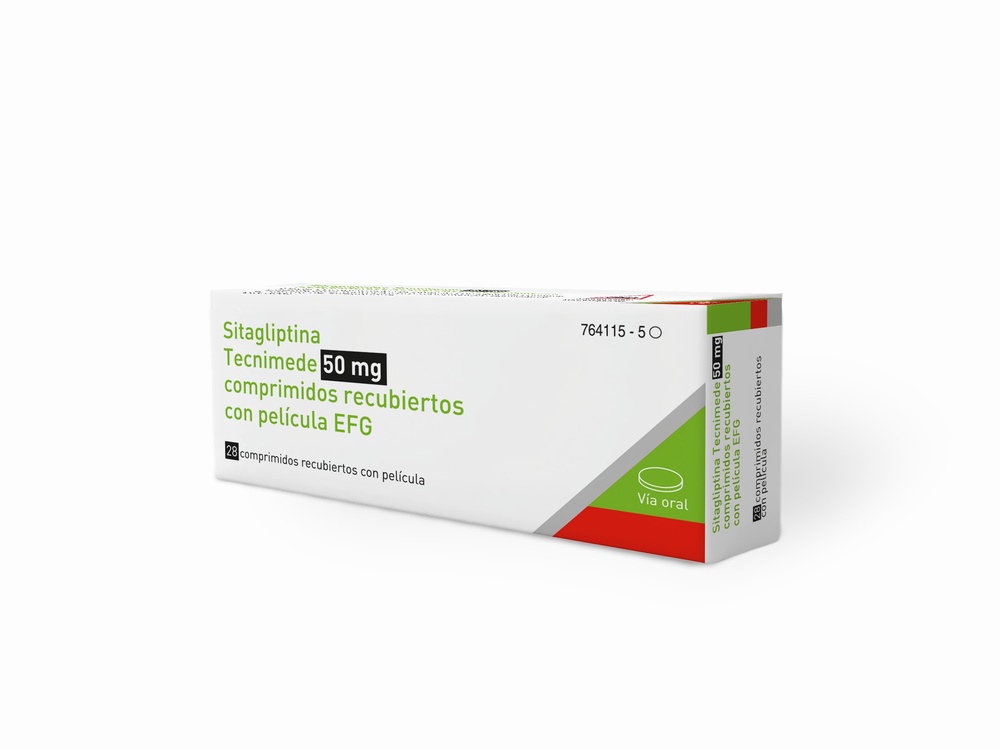

СИТАГЛІПТИН ТЕКНІМЕДЕ 50 мг ТАБЛЕТКИ, ПОКРИТІ ПЛІВКОВОЮ ОБОЛОНКОЮ

Запитайте лікаря про рецепт на СИТАГЛІПТИН ТЕКНІМЕДЕ 50 мг ТАБЛЕТКИ, ПОКРИТІ ПЛІВКОВОЮ ОБОЛОНКОЮ

Інструкція із застосування СИТАГЛІПТИН ТЕКНІМЕДЕ 50 мг ТАБЛЕТКИ, ПОКРИТІ ПЛІВКОВОЮ ОБОЛОНКОЮ
Вступ

Опис: інформація для пацієнта
Сітагліптин Tecnimede 50 мг покриті таблетки з плівковим покриттям EFG
Прочитайте уважно весь опис перед тим, як почати прийматицей лікарський засіб, оскільки він міститьважливу інформаціюдля вас.
- Збережіть цей опис, оскільки вам може знадобитися знову його прочитати.
- Якщо у вас є якісь питання, проконсультуйтеся з вашим лікарем або фармацевтом.
- Цей лікарський засіб призначений тільки вам, і не слід давати його іншим людям, навіть якщо вони мають такі самі симптоми, як і ви, оскільки це може зашкодити їм.
- Якщо ви відчуваєте побічні ефекти, проконсультуйтеся з вашим лікарем, фармацевтом або медсестрою, навіть якщо це побічні ефекти, які не вказані в цьому описі. Див. розділ 4.
Змістопису
- Що таке Сітагліптин Tecnimede і для чого він використовується
- Що потрібно знати перед тим, як почати приймати Сітагліптин Tecnimede
- Як приймати Сітагліптин Tecnimede
- Можливі побічні ефекти
- Збереження Сітагліптину Tecnimede
- Зміст упаковки та додаткова інформація
1. Що таке Сітагліптин Tecnimede і для чого він використовується
Цей лікарський засіб містить активну речовину сітагліптин, яка належить до класу лікарських засобів, званих інгібіторами ДПП-4 (інгібітори дипептидил-пептидази 4), які знижують рівень цукру в крові у дорослих пацієнтів з цукровим діабетом 2 типу.
Цей лікарський засіб допомагає збільшити рівень інсуліну, який виробляється після прийому їжі, і знижує кількість цукру, яку виробляє організм.
Ваш лікар призначив цей лікарський засіб, щоб допомогти вам знижувати рівень цукру в крові, який є надто високим через ваш цукровий діабет 2 типу. Цей лікарський засіб можна використовувати самостійно або в поєднанні з іншими лікарськими засобами (інсулін, метформін, сульфонілуреї або глітазони), які знижують рівень цукру в крові, і які ви вже приймаєте для лікування вашого цукрового діабету разом з програмою харчування та фізичних вправ.
Що таке цукровий діабет 2 типу?
Цукровий діабет 2 типу - це захворювання, при якому організм не виробляє достатньої кількості інсуліну, і інсулін, який виробляється, не працює так добре, як повинен. Організм також може виробляти надто багато цукру. Коли це відбувається, цукор (глюкоза) накопичується в крові. Це може призвести до серйозних медичних проблем, таких як захворювання серця, захворювання нирок, сліпота та ампутація.

2. Що потрібно знати перед тим, як почати приймати Сітагліптин Tecnimede
Не приймайте Сітагліптин Tecnimede
- якщо ви алергічні на сітагліптин або на будь-який інший компонент цього лікарського засобу (перелічені в розділі 6).
Попередженняіобережності
Було повідомлено про випадки запалення підшлункової залози (панкреатиту) у пацієнтів, які приймали сітагліптин (див. розділ 4).
Якщо ви спостерігаєте пухирі на шкірі, це може бути ознакою захворювання, званого пемфігусом буллозум. Ваш лікар може попросити вас припинити приймати сітагліптин.
Повідомте вашого лікаря, якщо ви страждаєте або страждали:
- захворюванням підшлункової залози (наприклад, панкреатитом)
- каменями в жовчному міхурі, алкоголізмом або високим рівнем тригліцеридів (типом жиру) в крові. Ці захворювання можуть збільшити вашу ймовірність розвитку панкреатиту (див. розділ 4)
- цукровим діабетом 1 типу
- кетоацидозом діабету (ускладненням цукрового діабету, яке призводить до високого рівня цукру в крові, швидкої втрати ваги, нудоти або блювоти)
- будь-якими проблемами з нирками, які ви мали раніше або маєте зараз
- алергічною реакцією на сітагліптин (див. розділ 4).
Менше ймовірно, що цей лікарський засіб призведе до зниження рівня цукру в крові, оскільки він не діє, коли рівень цукру в крові низький. Однак, коли цей лікарський засіб використовується в поєднанні з лікарськими засобами, які містять сульфонілуреї або інсулін, може виникнути зниження рівня цукру в крові (гіпоглікемія). Ваш лікар може зменшити дозу вашого лікарського засобу, який містить сульфонілуреї або інсулін.
Дітиіпідлітки
Діти та підлітки молодші 18 років не повинні приймати цей лікарський засіб. Він не є ефективним у дітей та підлітків у віці від 10 до 17 років. Не відомо, чи є цей лікарський засіб безпечним і ефективним, коли його використовують у дітей молодших 10 років.
Іншілікарські засобиіTecnimede
Повідомте вашого лікаря або фармацевта, якщо ви приймаєте, нещодавно приймали або можете приймати будь-який інший лікарський засіб.
Зокрема, повідомте вашого лікаря, якщо ви приймаєте дигоксин (лікарський засіб, який використовується для лікування нерегулярного серцебиття та інших проблем з серцем). Можливо, буде потрібно перевірити рівень дигоксину в вашій крові, якщо ви приймаєте сітагліптин.
Прийом Сітагліптину Tecnimede з їжею та напоямиВи можете приймати цей лікарський засіб з їжею або без неї.
Вагітність,грудне вигодовуванняіфертильність
Якщо ви вагітні або годуєте грудьми, вважаєте, що можете бути вагітною або плануєте завагітніти, проконсультуйтеся з вашим лікарем або фармацевтом перед тим, як приймати цей лікарський засіб. Не слід приймати цей лікарський засіб під час вагітності.
Не відомо, чи проникає цей лікарський засіб у грудне молоко. Не слід приймати цей лікарський засіб, якщо ви годуєте грудьми або плануєте це робити.

Водінняівикористаннямашин
Вплив цього лікарського засобу на можливість водіння транспортних засобів або використання машин є мінімальним або відсутнім. Однак, було повідомлено про випадки головокружіння та сонливості, які можуть впливати на вашу можливість водіння транспортних засобів або використання машин.
Також, прийом цього лікарського засобу разом з лікарськими засобами, які називаються сульфонілуреями або інсуліном, може призвести до гіпоглікемії, яка може впливати на вашу можливість водіння транспортних засобів або використання машин або виконання роботи без певної підтримки.
Tecnimede містить натрій
Цей лікарський засіб містить менше 1 ммоль натрію (23 мг) на одну таблетку з плівковим покриттям; тобто, він практично не містить натрію.
3. Як приймати Сітагліптин Tecnimede
Слідуйте точно інструкціям щодо прийому цього лікарського засобу, які вказані вашим лікарем. У разі сумнівів проконсультуйтеся з вашим лікарем або фармацевтом.
Звичайна рекомендована доза:
- одна таблетка по 100 мг з плівковим покриттям
- один раз на добу
- перорально.
Якщо у вас є проблеми з нирками, ваш лікар може призначити вам нижчі дози (наприклад, 25 мг або 50 мг).
Ви можете приймати цей лікарський засіб з їжею або без неї.
Ваш лікар може призначити вам цей лікарський засіб самостійно або в поєднанні з іншими лікарськими засобами, які також знижують рівень цукру в крові. Дієта та фізичні вправи можуть допомогти організму краще використовувати цукор. важливо слідувати дієті та фізичним вправам, які рекомендував ваш лікар, під час прийому сітагліптину.
ЯкщовиприймаєтебільшеTecnimede,ніжслід
Якщо ви приймаєте більшу дозу цього лікарського засобу, ніж призначена, негайно зверніться до вашого лікаря.
У разі передозування або випадкового прийому проконсультуйтеся з вашим лікарем або фармацевтом або зверніться до служби токсикологічної інформації, телефон: 91 562 04 20, вказавши лікарський засіб і кількість, яку ви прийняли.
ЯкщовизабулиприйнятиTecnimede
Якщо ви забули прийняти одну дозу, прийміть її, як тільки вам нагадаєте. Якщо ви не нагадаєте до часу прийому наступної дози, то пропустіть забуту дозу і продовжуйте приймати лікарський засіб згідно з вашим звичайним графіком. Не приймайте подвійну дозу цього лікарського засобу.
ЯкщовиперериваєтелікуваннязTecnimede
Продовжуйте приймати цей лікарський засіб, поки ваш лікар не призначить інше. Ви не повинні припиняти приймати цей лікарський засіб без попередньої консультації з вашим лікарем.
Якщо у вас є будь-які інші питання щодо прийому цього лікарського засобу, проконсультуйтеся з вашим лікарем або фармацевтом.

4. Можливі побічні ефекти
Як і всі лікарські засоби, цей лікарський засіб може призвести до побічних ефектів, хоча не всі люди їх відчувають.
ПЕРЕРВ'ЯТЕприйом Сітагліптину Tecnimede і зверніться до лікаря негайно, якщо ви відчуваєте будь-які з наступних серйозних побічних ефектів:
- Сильний і тривалий біль у животі (області живота) з можливим поширенням на спину та супроводжуваний нудотою та блювотою, оскільки ці можуть бути ознаками запалення підшлункової залози (панкреатиту).
Якщо у вас є серйозна алергічна реакція (частота невідома), включаючи висип, кропив'янку, пухирі на шкірі/лущення шкіри та набряк обличчя, губ, язика та горла, який може призвести до труднощів з диханням або ковтанням, припиніть приймати цей лікарський засіб і зверніться до лікаря негайно. Ваш лікар призначить вам лікарський засіб для лікування алергічної реакції та змінить лікарський засіб для лікування цукрового діабету.
Деякі пацієнти відчували наступні побічні ефекти після додавання сітагліптину до лікування метформіном:
Часті (можуть впливати до 1 особи з 10): зниження рівня цукру в крові, нудота, метеоризм, блювота
Рідкі (можуть впливати до 1 особи з 100): біль у животі, діарея, запор, сонливість.
Деякі пацієнти відчували різні види нездужань у шлунку, коли почали приймати сітагліптин і метформін одночасно (частота класифікована як часта).
Деякі пацієнти відчували наступні побічні ефекти, коли приймали сітагліптин у поєднанні з сульфонілуреєю та метформіном:
Дуже часті (можуть впливати більше 1 особи з 10): зниження рівня цукру в крові
Часті: запор
Деякі пацієнти відчували наступні побічні ефекти, коли приймали сітагліптин і піоглітазон:
Часті: метеоризм, набряк рук або ніг
Деякі пацієнти відчували наступні побічні ефекти, коли приймали сітагліптин у поєднанні з піоглітазоном та метформіном:
Часті: набряк рук або ніг
Деякі пацієнти відчували наступні побічні ефекти, коли приймали сітагліптин у поєднанні з інсуліном (з або без метформіну):
Часті: грип
Рідкі: сухість у роті
Деякі пацієнти відчували наступні побічні ефекти, коли приймали сітагліптин самостійно під час клінічних досліджень або після затвердження, самостійно або в поєднанні з іншими лікарськими засобами для лікування цукрового діабету:
Часті: зниження рівня цукру в крові, головний біль, інфекції верхніх дихальних шляхів, кон'юнктивіт та біль у горлі, артроз, біль у руках або ногах
Рідкі: головокружіння, запор, свербіж
Рідкісні: зниження кількості тромбоцитів
Частота невідома: проблеми з нирками (які іноді потребують діалізу), блювота, біль у суглобах, біль у м'язах, біль у спині, захворювання легенів, пемфігус буллозум (тип пухирів на шкірі)

Сповіщення про підозрювані побічні ефекти
Важливо сповіщати про підозрювані побічні ефекти лікарського засобу після його затвердження. Це дозволяє продовжувати моніторинг співвідношення користі та ризику лікарського засобу. Професійним медичним працівникам пропонується сповіщати про підозрювані побічні ефекти через
Систему моніторингу лікарських засобів України: https://www.notificaram.es.
5. Збереження Сітагліптину Tecnimede
Тримайте цей лікарський засіб поза досяжністю дітей.
Не використовуйте цей лікарський засіб після закінчення терміну його дії, який вказаний на блистерній упаковці та на зовнішній упаковці після CAD/EXP. Термін дії лікарського засобу - останній день місяця, який вказаний.
Цьому лікарському засобу не потрібні спеціальні умови зберігання.
Лікарські засоби не слід викидати у водопровідні труби або сміття. Віддавайте упаковки та лікарські засоби, які вам не потрібні, до пункту збору відходів у аптеці. У разі сумнівів проконсультуйтеся з фармацевтом, як позбуватися упаковок та лікарських засобів, які вам не потрібні. Таким чином, ви допоможете захистити навколишнє середовище.

6. Зміст упаковки та додаткова інформація
Склад Сітагліптину Tecnimede
Активна речовина - сітагліптин.
Кожна таблетка з плівковим покриттям містить сітагліптин гідрохлорид моногідрат, еквівалентний 50 мг сітагліптину.
Інші компоненти:
У складі таблетки: мікрокристалічна целюлоза (Е 460), гідрогенфосфат кальцію, кроскармелоза натрію (Е 468), колоїдна діоксид силіцию, фумарат стеарату натрію, стеарат магнію (Е470b).
Плівкове покриття таблетки містить: полі(алкоголь вінілу) (Е1203), діоксид титану (Е171), макрогол 3350 (Е1521), тальк (Е553b), оксид заліза жовтий (Е172), оксид заліза червоний (Е172)
Вигляд продукту та вміст упаковки
Таблетки з плівковим покриттям світло-коричневого кольору, круглі, з гравіюванням "S" на одній стороні
Сітагліптин Tecnimede випускається в блистерних упаковках (ПВХ/ПЕ/ПВДК та алюміній). Упаковки по 10, 28, 30, 60 та 98 таблеток з плівковим покриттям
Можливо, що тільки деякі розміри упаковок будуть випускатися.
Власник авторизації на розміщення лікарського засобу на ринку та відповідальна особа за виробництво
Tecnimede Іспанія Промисловість Фармацевтична S.A.
Авда. де Брюсселя, 13, 3-й Д.
28108 Алькобендас (Мадрид)
Іспанія
Відповідальна особа за виробництво
SAG ВИРОБНИЦТВО, S.L.U.
КТРА. Н-І, КМ 36. 28750 Сан-Агустін-де-Гуадалікс, Мадрид (Іспанія)
GALENICUM Здоров'я, S.L.U
Сант Габріель, 50
Есплугес-де-Льобрегат, 08950
Барселона, Іспанія

Дата останнього перегляду цього опису:Листопад 2023
Детальна інформація про цей лікарський засіб доступна на сайті Державної служби України з лікарських засобів http://www.dslpz.gov.ua/

Скільки коштує СИТАГЛІПТИН ТЕКНІМЕДЕ 50 мг ТАБЛЕТКИ, ПОКРИТІ ПЛІВКОВОЮ ОБОЛОНКОЮ в Іспанії у 2025 році?
СИТАГЛІПТИН ТЕКНІМЕДЕ 50 мг ТАБЛЕТКИ, ПОКРИТІ ПЛІВКОВОЮ ОБОЛОНКОЮ коштує в середньому 13.27 євро у грудень, 2025 році. Ціна може змінюватися залежно від регіону, аптеки та наявності рецепта. Рекомендуємо перевіряти актуальну вартість у місцевих аптеках або через онлайн-сервіси.
- Країна реєстрації
- Середня ціна в аптеках13.27 EUR
- Діючі речовини
- Потрібен рецептТак
- Виробник
- Інформація є довідковою і не є медичною порадою. Перед прийомом будь-яких препаратів обов'язково проконсультуйтеся з лікарем. Oladoctor не несе відповідальності за медичні рішення, прийняті на основі цього контенту.
- Альтернативи до СИТАГЛІПТИН ТЕКНІМЕДЕ 50 мг ТАБЛЕТКИ, ПОКРИТІ ПЛІВКОВОЮ ОБОЛОНКОЮФорма випуску: ТАБЛЕТКА, 100 мгДіючі речовини: sitagliptinВиробник: Laboratorios Alter S.A.Потрібен рецептФорма випуску: ТАБЛЕТКА, 25 мгДіючі речовини: sitagliptinВиробник: Laboratorios Alter S.A.Потрібен рецептФорма випуску: ТАБЛЕТКА, 50 мгДіючі речовини: sitagliptinВиробник: Laboratorios Alter S.A.Потрібен рецепт
Аналоги СИТАГЛІПТИН ТЕКНІМЕДЕ 50 мг ТАБЛЕТКИ, ПОКРИТІ ПЛІВКОВОЮ ОБОЛОНКОЮ в інших країнах
Найкращі аналоги з тією самою діючою речовиною та терапевтичним ефектом.
Аналог СИТАГЛІПТИН ТЕКНІМЕДЕ 50 мг ТАБЛЕТКИ, ПОКРИТІ ПЛІВКОВОЮ ОБОЛОНКОЮ у Polska
Аналог СИТАГЛІПТИН ТЕКНІМЕДЕ 50 мг ТАБЛЕТКИ, ПОКРИТІ ПЛІВКОВОЮ ОБОЛОНКОЮ у Ukraina
Лікарі онлайн щодо СИТАГЛІПТИН ТЕКНІМЕДЕ 50 мг ТАБЛЕТКИ, ПОКРИТІ ПЛІВКОВОЮ ОБОЛОНКОЮ
Консультація щодо дозування, побічних ефектів, взаємодій, протипоказань та поновлення рецепта на СИТАГЛІПТИН ТЕКНІМЕДЕ 50 мг ТАБЛЕТКИ, ПОКРИТІ ПЛІВКОВОЮ ОБОЛОНКОЮ – за рішенням лікаря та згідно з місцевими правилами.










